Abstract
Dyspepsia is common in the general population, and despite a paucity of data, smoking, alcohol, and analgesics are believed to be important risk factors. The role of these environmental factors in subjects with uninvestigated dyspepsia was evaluated in a representative population sample. An age and gender stratified random sample of residents of Olmsted County, Minnesota, aged 20 to 64 years was mailed a valid self report questionnaire; 77% responded (n = 1644). Age and gender adjusted (1990 US white population) prevalence rates for dyspepsia (defined as frequent pain located in the upper abdomen, or nausea in the absence of a history of peptic ulcer disease) were calculated. Logistic regression analysis was used to estimate the association between dyspepsia and potential risk factors. The age and gender adjusted prevalence (per 100) of dyspepsia in the community was 21.8 (95% confidence interval 19.6, 23.9). Dyspepsia was significantly more common in younger subjects and females. Adjusting for age and gender, paracetamol (odds ratio (OR) = 2.2), aspirin (OR = 1.8), and smoking (OR = 1.5), but not alcohol (OR = 0.9), were associated with dyspepsia (all p < 0.05). When non-gastrointestinal somatic complaints were included in the logistic models, however, these environmental factors were no longer significant (OR = 1.3, 1.1, 1.2 and 0.9, respectively). Similar results were obtained when ulcer-like, dysmotility-like, and reflux-like dyspepsia were considered separately. The results were not significantly changed when subjects with a history of ulcer disease were included in the analyses. Smoking, alcohol, and analgesics may not therefore be important risk factors for dyspepsia in the community.
Full text
PDF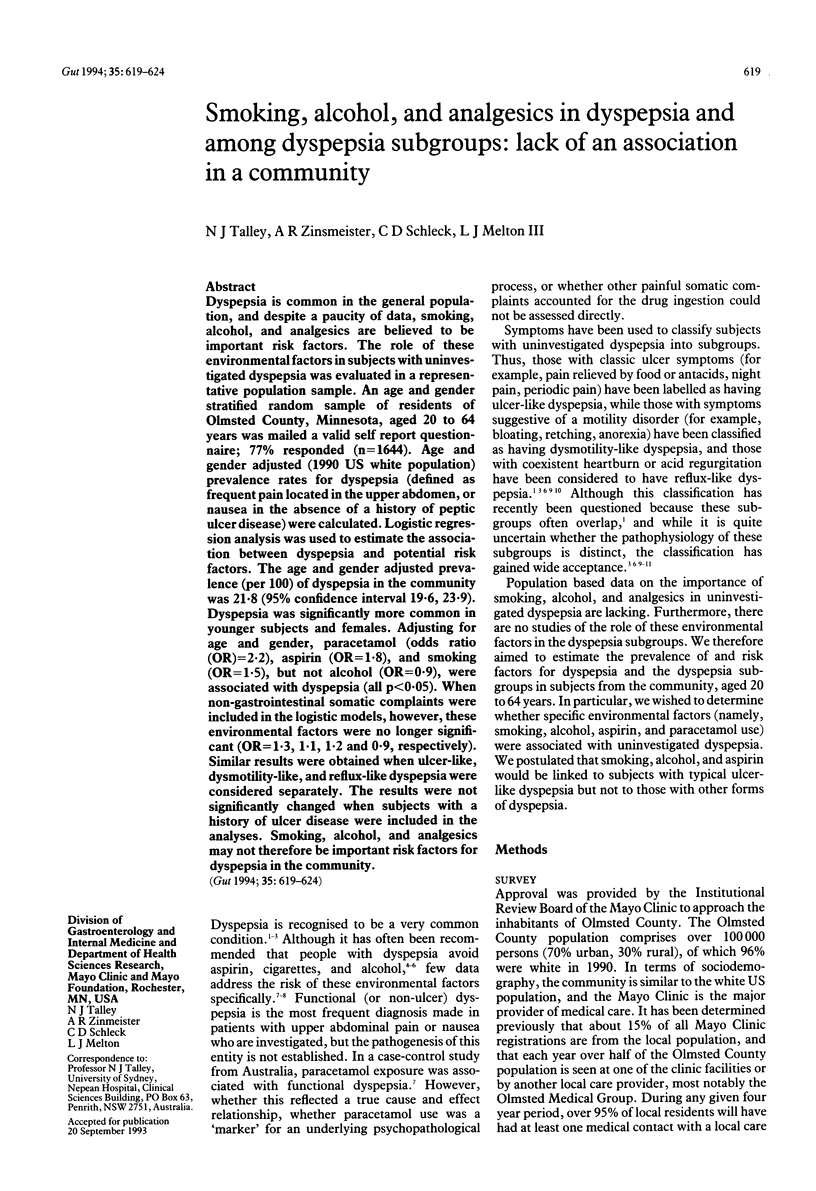
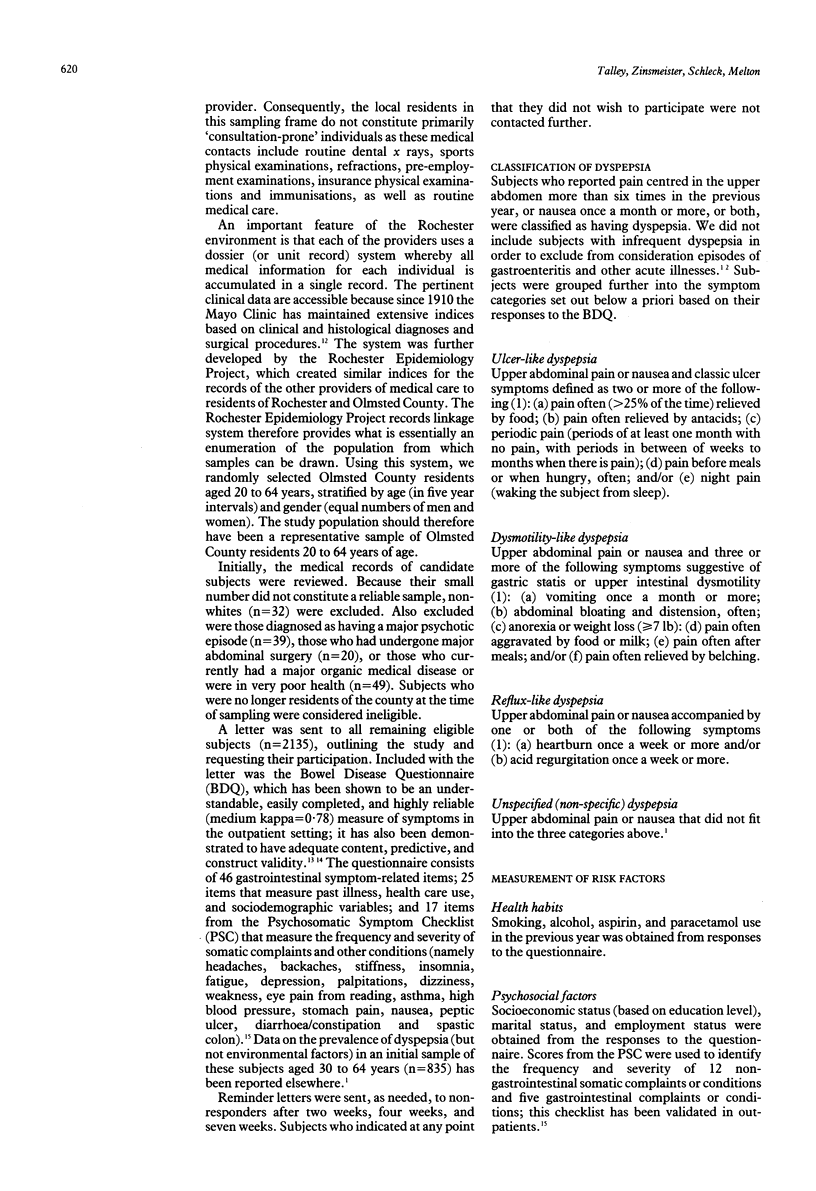
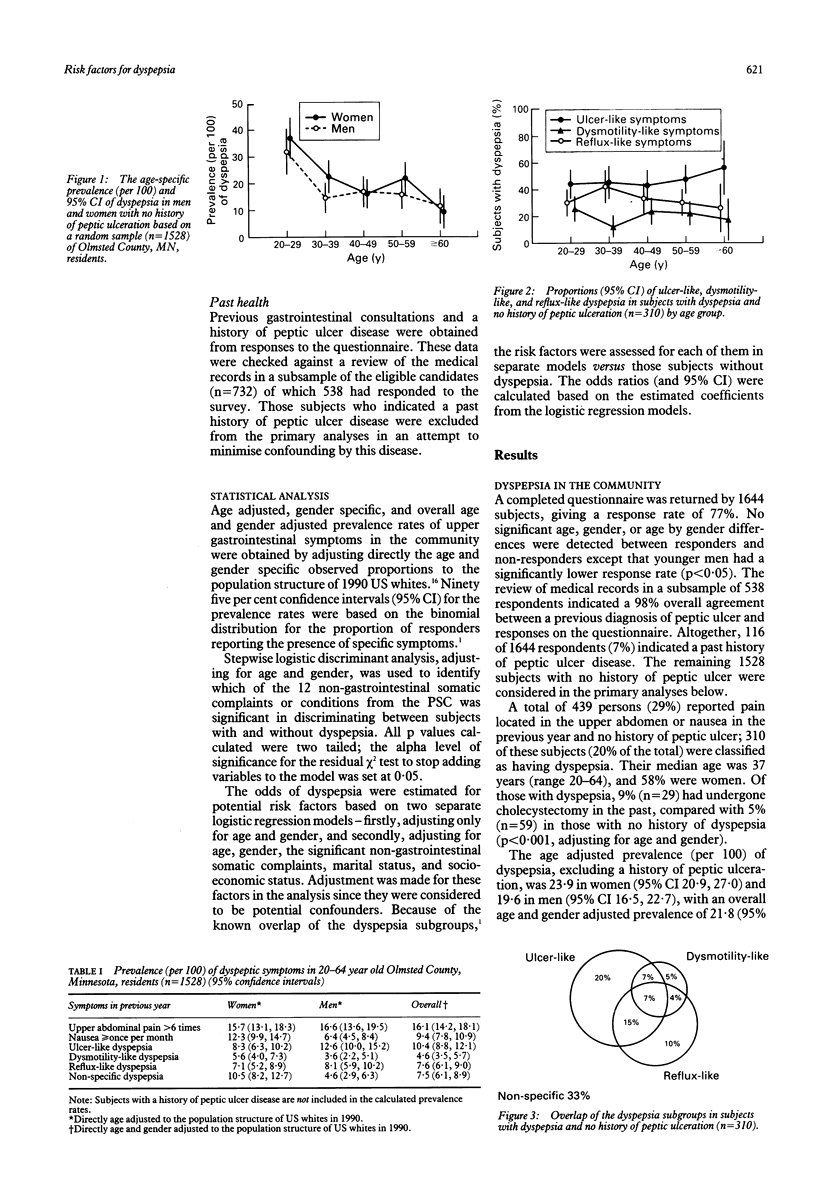
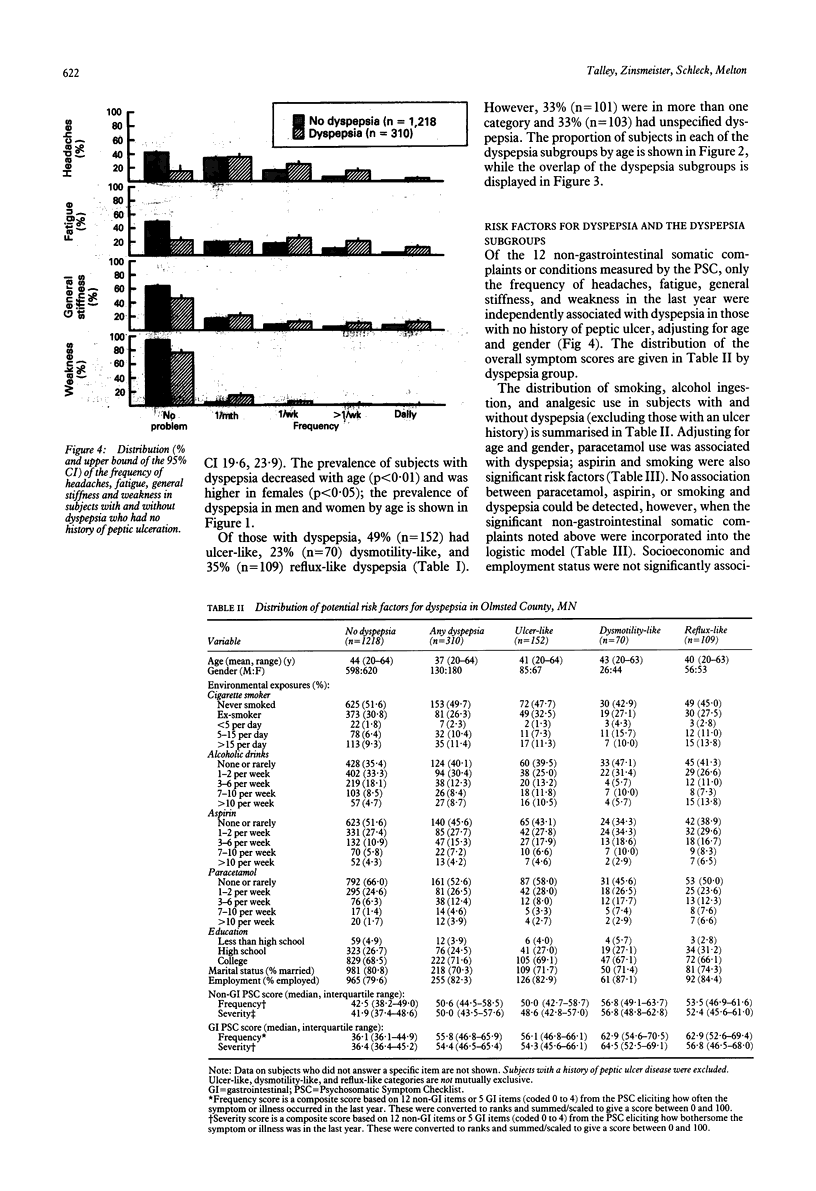
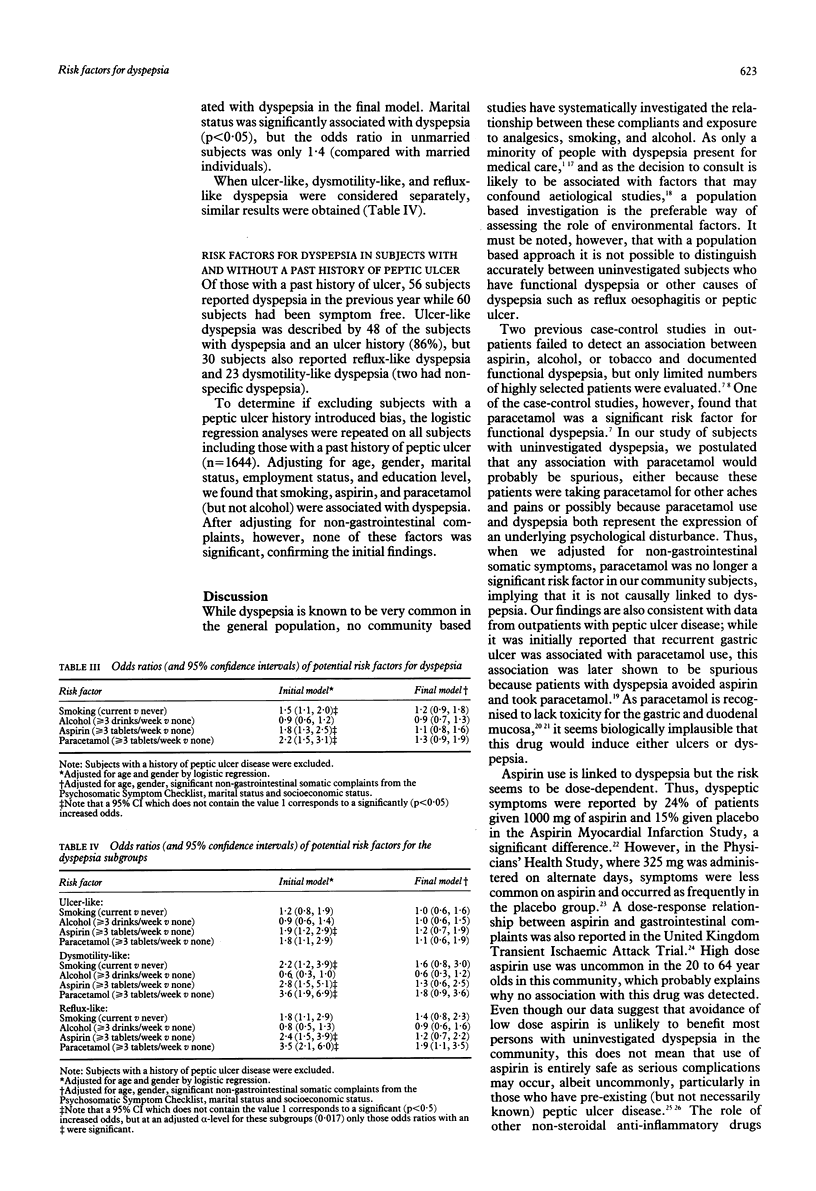
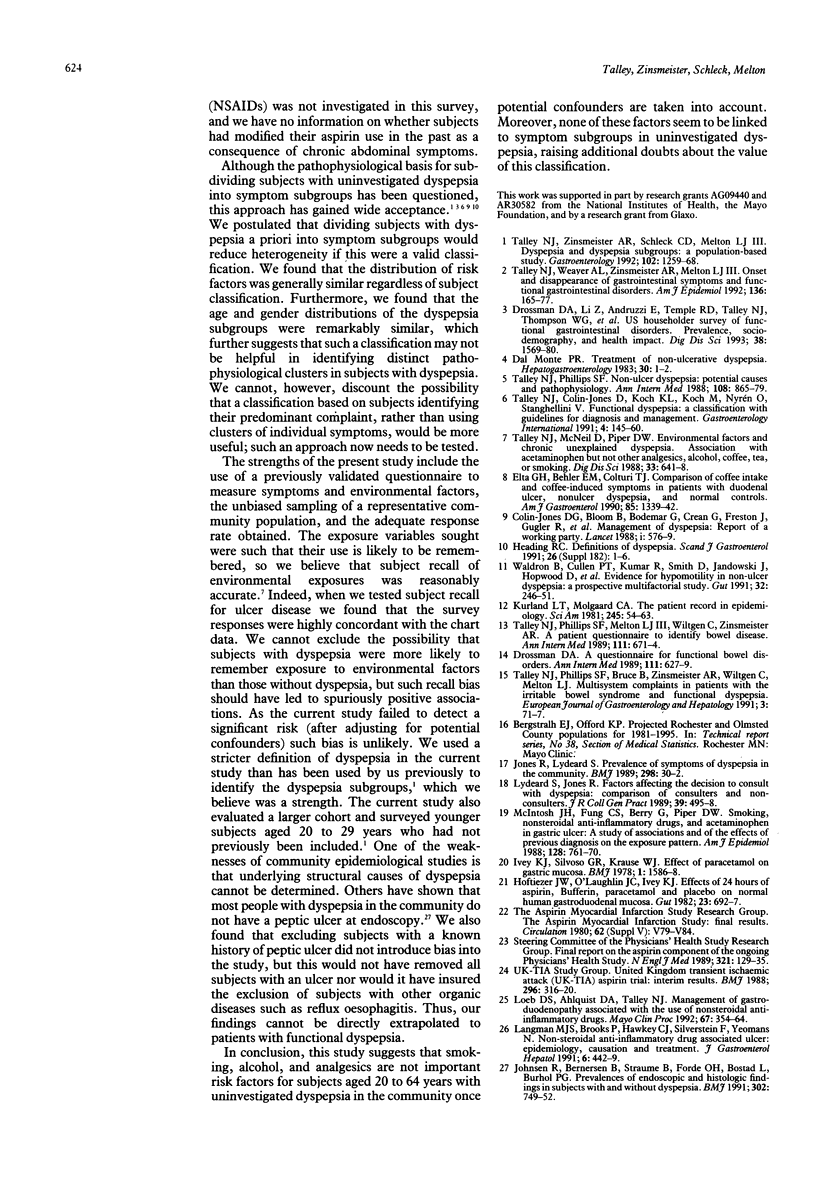
Selected References
These references are in PubMed. This may not be the complete list of references from this article.
- Dal Monte P. R. Treatment of non-ulcerative dyspepsia. Hepatogastroenterology. 1983 Feb;30(1):1–2. [PubMed] [Google Scholar]
- Drossman D. A. A questionnaire for functional bowel disorders. Ann Intern Med. 1989 Oct 15;111(8):627–629. doi: 10.7326/0003-4819-111-8-627. [DOI] [PubMed] [Google Scholar]
- Drossman D. A., Li Z., Andruzzi E., Temple R. D., Talley N. J., Thompson W. G., Whitehead W. E., Janssens J., Funch-Jensen P., Corazziari E. U.S. householder survey of functional gastrointestinal disorders. Prevalence, sociodemography, and health impact. Dig Dis Sci. 1993 Sep;38(9):1569–1580. doi: 10.1007/BF01303162. [DOI] [PubMed] [Google Scholar]
- Elta G. H., Behler E. M., Colturi T. J. Comparison of coffee intake and coffee-induced symptoms in patients with duodenal ulcer, nonulcer dyspepsia, and normal controls. Am J Gastroenterol. 1990 Oct;85(10):1339–1342. [PubMed] [Google Scholar]
- Heading R. C. Definitions of dyspepsia. Scand J Gastroenterol Suppl. 1991;182:1–6. doi: 10.3109/00365529109109529. [DOI] [PubMed] [Google Scholar]
- Hoftiezer J. W., O'Laughlin J. C., Ivey K. J. Effects of 24 hours of aspirin, Bufferin, paracetamol and placebo on normal human gastroduodenal mucosa. Gut. 1982 Aug;23(8):692–697. doi: 10.1136/gut.23.8.692. [DOI] [PMC free article] [PubMed] [Google Scholar]
- Ivey R. J., Silvoso G. R., Krause W. J. Effect of paracetamol on gastric mucosa. Br Med J. 1978 Jun 17;1(6127):1586–1588. doi: 10.1136/bmj.1.6127.1586. [DOI] [PMC free article] [PubMed] [Google Scholar]
- Johnsen R., Bernersen B., Straume B., Førde O. H., Bostad L., Burhol P. G. Prevalences of endoscopic and histological findings in subjects with and without dyspepsia. BMJ. 1991 Mar 30;302(6779):749–752. doi: 10.1136/bmj.302.6779.749. [DOI] [PMC free article] [PubMed] [Google Scholar]
- Kurland L. T., Molgaard C. A. The patient record in epidemiology. Sci Am. 1981 Oct;245(4):54–63. doi: 10.1038/scientificamerican1081-54. [DOI] [PubMed] [Google Scholar]
- Langman M. J., Brooks P., Hawkey C. J., Silverstein F., Yeomans N. Non-steroid anti-inflammatory drug associated ulcer: epidemiology, causation and treatment. J Gastroenterol Hepatol. 1991 Sep-Oct;6(5):442–449. doi: 10.1111/j.1440-1746.1991.tb00885.x. [DOI] [PubMed] [Google Scholar]
- Loeb D. S., Ahlquist D. A., Talley N. J. Management of gastroduodenopathy associated with use of nonsteroidal anti-inflammatory drugs. Mayo Clin Proc. 1992 Apr;67(4):354–364. doi: 10.1016/s0025-6196(12)61552-3. [DOI] [PubMed] [Google Scholar]
- Lydeard S., Jones R. Factors affecting the decision to consult with dyspepsia: comparison of consulters and non-consulters. J R Coll Gen Pract. 1989 Dec;39(329):495–498. [PMC free article] [PubMed] [Google Scholar]
- Management of dyspepsia: report of a working party. Lancet. 1988 Mar 12;1(8585):576–579. [PubMed] [Google Scholar]
- McIntosh J. H., Fung C. S., Berry G., Piper D. W. Smoking, nonsteroidal anti-inflammatory drugs, and acetaminophen in gastric ulcer. A study of associations and of the effects of previous diagnosis on exposure patterns. Am J Epidemiol. 1988 Oct;128(4):761–770. doi: 10.1093/oxfordjournals.aje.a115029. [DOI] [PubMed] [Google Scholar]
- Talley N. J., McNeil D., Piper D. W. Environmental factors and chronic unexplained dyspepsia. Association with acetaminophen but not other analgesics, alcohol, coffee, tea, or smoking. Dig Dis Sci. 1988 Jun;33(6):641–648. doi: 10.1007/BF01540424. [DOI] [PubMed] [Google Scholar]
- Talley N. J., Phillips S. F., Melton J., 3rd, Wiltgen C., Zinsmeister A. R. A patient questionnaire to identify bowel disease. Ann Intern Med. 1989 Oct 15;111(8):671–674. doi: 10.7326/0003-4819-111-8-671. [DOI] [PubMed] [Google Scholar]
- Talley N. J., Phillips S. F. Non-ulcer dyspepsia: potential causes and pathophysiology. Ann Intern Med. 1988 Jun;108(6):865–879. doi: 10.7326/0003-4819-108-6-865. [DOI] [PubMed] [Google Scholar]
- Talley N. J., Weaver A. L., Zinsmeister A. R., Melton L. J., 3rd Onset and disappearance of gastrointestinal symptoms and functional gastrointestinal disorders. Am J Epidemiol. 1992 Jul 15;136(2):165–177. doi: 10.1093/oxfordjournals.aje.a116483. [DOI] [PubMed] [Google Scholar]
- Talley N. J., Zinsmeister A. R., Schleck C. D., Melton L. J., 3rd Dyspepsia and dyspepsia subgroups: a population-based study. Gastroenterology. 1992 Apr;102(4 Pt 1):1259–1268. [PubMed] [Google Scholar]
- Waldron B., Cullen P. T., Kumar R., Smith D., Jankowski J., Hopwood D., Sutton D., Kennedy N., Campbell F. C. Evidence for hypomotility in non-ulcer dyspepsia: a prospective multifactorial study. Gut. 1991 Mar;32(3):246–251. doi: 10.1136/gut.32.3.246. [DOI] [PMC free article] [PubMed] [Google Scholar]


